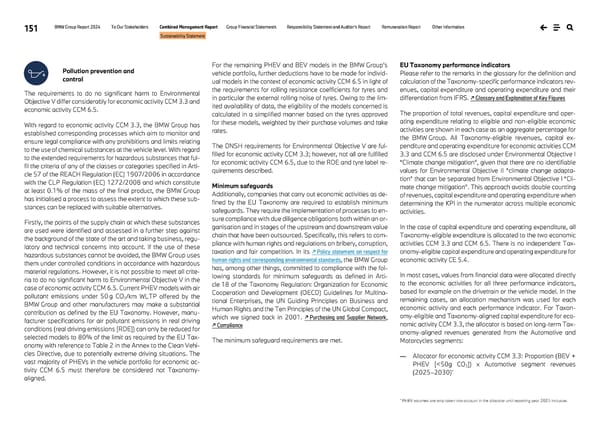151 BMW Group Report 2024 To Our Stakeholders Combined Management Report Group Financial Statements Responsibility Statement and Auditor’s Report Remuneration Report Other Information Sustainability Statement Pollution prevention and control The requirements to do no significant harm to Environmental Objective V differ considerably for economic activity CCM 3.3 and economic activity CCM 6.5. With regard to economic activity CCM 3.3, the BMW Group has established corresponding processes which aim to monitor and ensure legal compliance with any prohibitions and limits relating to the use of chemical substances at the vehicle level. With regard to the extended requirements for hazardous substances that ful- fil the criteria of any of the classes or categories specified in Arti- cle 57 of the REACH Regulation (EC) 1907/2006 in accordance with the CLP Regulation (EC) 1272/2008 and which constitute at least 0.1% of the mass of the final product, the BMW Group has initialised a process to assess the extent to which these sub- stances can be replaced with suitable alternatives. Firstly, the points of the supply chain at which these substances are used were identified and assessed in a further step against the background of the state of the art and taking business, regu- latory and technical concerns into account. If the use of these hazardous substances cannot be avoided, the BMW Group uses them under controlled conditions in accordance with hazardous material regulations. However, it is not possible to meet all crite- ria to do no significant harm to Environmental Objective V in the case of economic activity CCM 6.5. Current PHEV models with air pollutant emissions under 50 g CO2/km WLTP offered by the BMW Group and other manufacturers may make a substantial contribution as defined by the EU Taxonomy. However, manu- facturer specifications for air pollutant emissions in real driving conditions (real driving emissions [RDE]) can only be reduced for selected models to 80% of the limit as required by the EU Tax- onomy with reference to Table 2 in the Annex to the Clean Vehi- cles Directive, due to potentially extreme driving situations. The vast majority of PHEVs in the vehicle portfolio for economic ac- tivity CCM 6.5 must therefore be considered not Taxonomy- aligned. For the remaining PHEV and BEV models in the BMW Group’s vehicle portfolio, further deductions have to be made for individ- ual models in the context of economic activity CCM 6.5 in light of the requirements for rolling resistance coefficients for tyres and in particular the external rolling noise of tyres. Owing to the lim- ited availability of data, the eligibility of the models concerned is calculated in a simplified manner based on the tyres approved for these models, weighted by their purchase volumes and take rates. The DNSH requirements for Environmental Objective V are ful- filled for economic activity CCM 3.3; however, not all are fulfilled for economic activity CCM 6.5, due to the RDE and tyre label re- quirements described. Minimum safeguards Additionally, companies that carry out economic activities as de- fined by the EU Taxonomy are required to establish minimum safeguards. They require the implementation of processes to en- sure compliance with due diligence obligations both within an or- ganisation and in stages of the upstream and downstream value chain that have been outsourced. Specifically, this refers to com- pliance with human rights and regulations on bribery, corruption, taxation and fair competition. In its ↗ Policy statement on respect for human rights and corresponding environmental standards, the BMW Group has, among other things, committed to compliance with the fol- lowing standards for minimum safeguards as defined in Arti- cle 18 of the Taxonomy Regulation: Organization for Economic Cooperation and Development (OECD) Guidelines for Multina- tional Enterprises, the UN Guiding Principles on Business and Human Rights and the Ten Principles of the UN Global Compact, which we signed back in 2001. ↗ Purchasing and Supplier Network, ↗ Compliance The minimum safeguard requirements are met. EU Taxonomy performance indicators Please refer to the remarks in the glossary for the definition and calculation of the Taxonomy-specific performance indicators rev- enues, capital expenditure and operating expenditure and their differentiation from IFRS. ↗ Glossary and Explanation of Key Figures The proportion of total revenues, capital expenditure and oper- ating expenditure relating to eligible and non-eligible economic activities are shown in each case as an aggregate percentage for the BMW Group. All Taxonomy-eligible revenues, capital ex- penditure and operating expenditure for economic activities CCM 3.3 and CCM 6.5 are disclosed under Environmental Objective I “Climate change mitigation”, given that there are no identifiable values for Environmental Objective II “climate change adapta- tion” that can be separated from Environmental Objective I “Cli- mate change mitigation”. This approach avoids double counting of revenues, capital expenditure and operating expenditure when determining the KPI in the numerator across multiple economic activities. In the case of capital expenditure and operating expenditure, all Taxonomy-eligible expenditure is allocated to the two economic activities CCM 3.3 and CCM 6.5. There is no independent Tax- onomy-eligible capital expenditure and operating expenditure for economic activity CE 5.4. In most cases, values from financial data were allocated directly to the economic activities for all three performance indicators, based for example on the drivetrain or the vehicle model. In the remaining cases, an allocation mechanism was used for each economic activity and each performance indicator. For Taxon- omy-eligible and Taxonomy-aligned capital expenditure for eco- nomic activity CCM 3.3, the allocator is based on long-term Tax- onomy-aligned revenues generated from the Automotive and Motorcycles segments: — Allocator for economic activity CCM 3.3: Proportion (BEV + PHEV [
 BMW Group Report 2024 Page 150 Page 152
BMW Group Report 2024 Page 150 Page 152